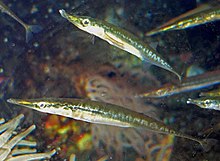Aulorhynchus
| Aulorhynchus | |
|---|---|

| |
| Scientific classification | |
| Domain: | Eukaryota |
| Kingdom: | Animalia |
| Phylum: | Chordata |
| Class: | Actinopterygii |
| Order: | Scorpaeniformes |
| Suborder: | Gasterosteoidei |
| Family: | Aulorhynchidae |
| Genus: | Aulorhynchus T. N. Gill, 1861 |
| Species: | A. flavidus
|
| Binomial name | |
| Aulorhynchus flavidus T. N. Gill, 1861
| |
Aulorhynchus is a monospecific genus of marine ray-finned fish belonging to the family Aulorhynchidae. Its only species is the tube-snout (Aulorhynchus flavidus) which is found off the western coast of North America.
Taxonomy[edit]
Aulorhynchus was first proposed as a genus in 1861 by the American zoologist Theodore Gill, when he described Aulorhynchus flavidus, placing it in a new monotypic genus.[2] The type locality is given as the coast of Washington.[3] This genus is included in the family Aulorhynchidae in the suborder Gasterosteoidei of the order Scorpaeniformes in the 5th edition of Fishes of the World.[4]
Etymology[edit]
Aulorhynchus, the genus name, is a combination of aulos, meaning "flute", and rhynchus, which means "snout", a reference to the flexible tubular snout of this species The specific name, flavidus means "yellowish".[5]
Description[edit]
This species grows to 18 cm (7.1 in) in total length. It physically resembles the sticklebacks, but has a thinner, longer body, with 24 to 27 small spines in front of the dorsal fin.
Biology[edit]
Aulorhynchus also possess a slender snout, hence the common name. Like the sticklebacks, it feeds on small invertebrates and fish larvae.[6]
Also, like sticklebacks, it produces a sticky secretion from its kidneys when breeding. Whereas sticklebacks use this secretion to bind plant matter together to create a nest, the tube-snout simply attaches its eggs to a substrate. Aulorhynchus attaches its eggs to kelp,[6] notably Macrocystis pyrifera.
Spawning occurs throughout the year, and males guard nest sites by actively defending them from predators. The nests are found at depths of 10–20 m and have been recorded up to 38 m.[7]
The tubesnout feeds on small planktonic crustaceans, including [amphipod]s, mysids, and crab larvae.
This species finds use as a denizen in public aquariums.
Habitat[edit]
The tubesnout is found in shallow marine waters off the Pacific coast of North America to a depth of 30 m (98 ft), from Prince William Sound in Alaska to Rompiente, Baja California. The species inhabits rocky crevices, kelp beds, eelgrass, and areas with a sandy bottom substrate.[7]
References[edit]
- Froese, Rainer, and Daniel Pauly, eds. (2012). "Aulorhynchidae" in FishBase. October 2012 version.
- Froese, Rainer; Pauly, Daniel (eds.) (2012). "Aulorhynchus flavidus" in FishBase. October 2012 version.
- ^ Pollom, R. (2017) [errata version of 2016 assessment]. "Aulorhynchus flavidus". IUCN Red List of Threatened Species. 2016: e.T65134524A115406876. doi:10.2305/IUCN.UK.2016-3.RLTS.T65134524A67618783.en. Retrieved 26 November 2022.
- ^ Theodore N. Gill (1861). "On a New Typs of Aulostomatoids, Found in Washington Territory". Proceedings of the Academy of Natural Sciences of Philadelphia. 13: 169–170. JSTOR 4059552.
- ^ Eschmeyer, William N.; Fricke, Ron & van der Laan, Richard (eds.). "Species in the genus Aulorhynchus". Catalog of Fishes. California Academy of Sciences. Retrieved 27 November 2022.
- ^ J. S. Nelson; T. C. Grande; M. V. H. Wilson (2016). Fishes of the World (5th ed.). Wiley. pp. 467–495. ISBN 978-1-118-34233-6. Archived from the original on 2019-04-08. Retrieved 2022-11-27.
- ^ Christopher Scharpf & Kenneth J. Lazara, eds. (3 August 2021). "Order Perciformes Suborder Cottoidea: Infraorder Gasterosteales: Families: Hypoptychidae, Aulorhynchidae and Gasterosteidae". The ETYFish Project Fish Name Etymology Database. Christopher Scharpf and Kenneth J. Lazara. Retrieved 25 November 2022.
- ^ a b Orr, J.W. & Pietsch, T.W. (1998). Paxton, J.R. & Eschmeyer, W.N. (eds.). Encyclopedia of Fishes. San Diego: Academic Press. p. 172. ISBN 0-12-547665-5.
- ^ a b Limbaugh, C. 1962. Life history and ecological notes on the Tubenose, Aulorhynchus flavidus, a hemibranch fish of western North America. Copeia 1962(3):549-555.

